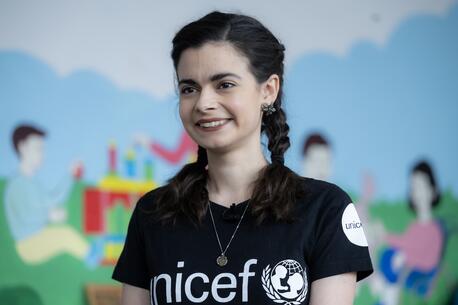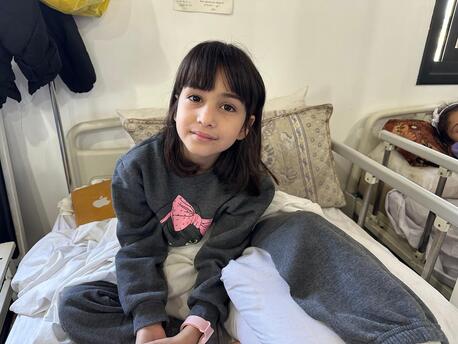Fighting Maternal and Neonatal Tetanus
Kuajok feels like the middle of nowhere.
Our journey began with an hour and half flight from South Sudan’s capital city Juba to the town of Aweil. From Aweil we drove nearly five hours on dusty potholed roads. At times our driver would slow down to 6 miles an hour to maneuver the massive craters.
I was in South Sudan to observe a seven-day immunization campaign supported by UNICEF and partners, including Kiwanis International. The Eliminate Project, a partnership between Kiwanis International and UNICEF, aims to protect women and their future newborns around the world from maternal and neonatal tetanus. The goal is to eliminate maternal and neonatal tetanus worldwide by 2015.
Melanie Sharpe, UNICEF Canada’s Media Relations Specialist, traveled to South Sudan in February with an editor from Elle Canada. They were there to observe a seven-day immunization campaign supported by UNICEF and partners, including Kiwanis International. The Eliminate Project, an ambitious partnership between Kiwanis International and UNICEF, aims to protect women and their future newborns around the world from maternal and neonatal tetanus.
Kuajok feels like the middle of nowhere.
Our journey began with an hour and half flight from South Sudan’s capital city Juba to the town of Aweil. From Aweil we drove nearly five hours on dusty potholed roads. At times our driver would slow down to 6 miles an hour to maneuver the massive craters.
 Vaccinator Nyakir Chol and health and nutrition specialist Paula Nuer give Akuol Akol Madeng her vaccine during the maternal and neonatal tetanus immunization campaign in South Sudan. ©UNICEF/Adriane Ohanesian
There is one main unpaved road where a few shopkeepers sell whatever items happen to make it to Kuajok. Vehicles, motorbikes, people and goats move through town surrounded by small grass roofed huts. This time of year the town is scorching hot, the air is dry and nothing moves quickly.
During our second afternoon in Kuajok I met a woman named Ajok Madut. Ajok was with two of her three children — nine-month-old Mauout and three year-old Acol. She told me she’s given birth seven times, but only three of her children are alive. Each time Ajok gave birth she was at home — in a small hut — by herself.
She explained that before giving birth she would lay a blanket down on the floor to lie on during the delivery. Once the baby arrived she cut the umbilical cord herself with a razor blade.
South Sudan has the highest maternal death rate in the world. For every 100,000 births more than 2,000 women will die. This means women have about a 1 in 7 chance of dying from pregnancy-related complications in their lifetime. So Ajok is one of the lucky mothers — statistically, she should be dead by now.
Vaccinator Nyakir Chol and health and nutrition specialist Paula Nuer give Akuol Akol Madeng her vaccine during the maternal and neonatal tetanus immunization campaign in South Sudan. ©UNICEF/Adriane Ohanesian
There is one main unpaved road where a few shopkeepers sell whatever items happen to make it to Kuajok. Vehicles, motorbikes, people and goats move through town surrounded by small grass roofed huts. This time of year the town is scorching hot, the air is dry and nothing moves quickly.
During our second afternoon in Kuajok I met a woman named Ajok Madut. Ajok was with two of her three children — nine-month-old Mauout and three year-old Acol. She told me she’s given birth seven times, but only three of her children are alive. Each time Ajok gave birth she was at home — in a small hut — by herself.
She explained that before giving birth she would lay a blanket down on the floor to lie on during the delivery. Once the baby arrived she cut the umbilical cord herself with a razor blade.
South Sudan has the highest maternal death rate in the world. For every 100,000 births more than 2,000 women will die. This means women have about a 1 in 7 chance of dying from pregnancy-related complications in their lifetime. So Ajok is one of the lucky mothers — statistically, she should be dead by now.
 Women gather under a tree during the maternal and neonatal tetanus immunization campaign in Kuajok, South Sudan. ©UNICEF/Adriane Ohanesian
I met Ajok under a huge tree behind the Kuajok primary health care unit where UNICEF had set up one of its tetanus vaccination points. UNICEF was in the middle of a seven-day vaccination campaign to protect women from maternal and neonatal tetanus across the country.
People of all ages can get tetanus, but it’s particularly serious for newborn babies and for women who have no choice but to give birth in unclean environments — women like Ajok. The effects are devastating — within days tetanus spreads through a baby’s body, causing convulsions and difficulty breathing. Without hospital care, as many as 95% of babies will die.
But thanks to partnerships like The Eliminate Project, UNICEF, Kiwanis International and other partners are working to eliminate the disease worldwide by 2015. Reaching women like Ajok in remote communities is absolutely vital to achieving this goal.
To support The Eliminate Project, please visit our donation page.
Women gather under a tree during the maternal and neonatal tetanus immunization campaign in Kuajok, South Sudan. ©UNICEF/Adriane Ohanesian
I met Ajok under a huge tree behind the Kuajok primary health care unit where UNICEF had set up one of its tetanus vaccination points. UNICEF was in the middle of a seven-day vaccination campaign to protect women from maternal and neonatal tetanus across the country.
People of all ages can get tetanus, but it’s particularly serious for newborn babies and for women who have no choice but to give birth in unclean environments — women like Ajok. The effects are devastating — within days tetanus spreads through a baby’s body, causing convulsions and difficulty breathing. Without hospital care, as many as 95% of babies will die.
But thanks to partnerships like The Eliminate Project, UNICEF, Kiwanis International and other partners are working to eliminate the disease worldwide by 2015. Reaching women like Ajok in remote communities is absolutely vital to achieving this goal.
To support The Eliminate Project, please visit our donation page.
 Vaccinator Nyakir Chol and health and nutrition specialist Paula Nuer give Akuol Akol Madeng her vaccine during the maternal and neonatal tetanus immunization campaign in South Sudan. ©UNICEF/Adriane Ohanesian
Vaccinator Nyakir Chol and health and nutrition specialist Paula Nuer give Akuol Akol Madeng her vaccine during the maternal and neonatal tetanus immunization campaign in South Sudan. ©UNICEF/Adriane Ohanesian Women gather under a tree during the maternal and neonatal tetanus immunization campaign in Kuajok, South Sudan. ©UNICEF/Adriane Ohanesian
Women gather under a tree during the maternal and neonatal tetanus immunization campaign in Kuajok, South Sudan. ©UNICEF/Adriane Ohanesian

